Something's Fishy: Picking on pike
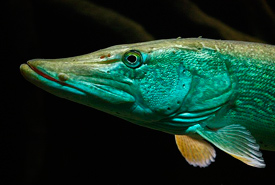
Northern pike (Photo by Dirk Godlinski)
There is a special day in every fisherman and -woman’s life where they reel in a fish that gives them a one-way ticket into the big players' club. Freshwater anglers across Canada dream of encountering these beasts, some adult species measuring from a half-metre up to two metres in length.
My special day came while I was helping collect a population survey of fish in Lake Ontario. Although I wasn’t the one with it on my line, I held that northern pike like it was a trophy, my hands trying to get a hold on its slippery body, long and strong with a mouth full of tiny teeth I was warned to stay clear of. Basking in the glory of the moment, I released the fish back into the water and watched its majestic body slowly swim away into the murky depths.
Pike come in many different variations. Belonging to the genus Esox, the five pike species native to North America include northern pike, muskellunge and chain pickerel, and subspecies grass pickerel and redfin pickerel. Amur pike, or black-spotted pike, is native to Amur Valley in Siberia but in the 1960s was stocked in Glendale Lake in Pennsylvania. Hybrids of Amur pike and northern pike were stocked in this Glendale Lake by the Pennsylvania Fish Commission, and a few may still exist although none have been reported for several years.
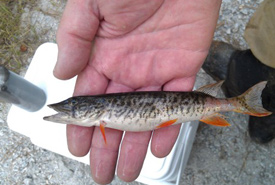
Redfin pickerel (Photo from Wikimedia Commons)
The most distinctive characteristic of the pike family is the species' “duck bill”; the long, flattened snout filled with several sharp teeth that extends from the fish's bony forehead. Pike have a single, rounded dorsal fin far back on their body, near their forked tail. The dorsal fin is parallel to the anal fin, which is also rounded. This physique allows pike to swim swiftly towards their prey, making them one of the fiercest species in Canadian freshwaters. Pike’s scales are circular, smooth and embedded with mucus; a characteristic that was developed as a defense mechanism.
Pike do best in coldwater streams, rivers and lakes and have a carnivorous diet. They hunt and nest in submerged vegetation such as pondweed, although muskellunge are known to occupy rocky lake shoals. Pike are able to remain concealed from prey and predators due to their camouflage patterns varying between stripes, bands and chain-like markings of light and dark tones.
These markings differ between species. Generally, pike are a mixture of shades of browns and greens. Some species, such as redfin pickerel, have red-orange fins. Pike have large yellow eyes; a key characteristic that helps identify the species.
The smallest member of the pike family is the redfin pickerel, reaching up to only 12 inches. In Canada, this subspecies can be found in southwestern Quebec, specifically in the St. Lawrence River.
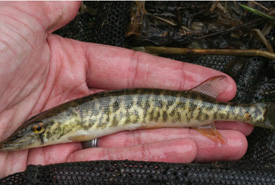
Grass pickerel (Photo by Brian Zimmerman)
This subspecies is frequently confused with another subspecies of the pike family, the grass pickerel (or American pickerel), due to its similar size. Key indicators of the redfin subspecies are its red fins and distinct, dark markings. Both of these subspecies however are often mistaken for young northern pike and muskellunge. Juvenile fish of both the redfin and grass pickerel subspecies are known to eat invertebrates, while the adults consume small fish and crayfish.
In Ontario grass pickerel is considered a species of special concern, meaning the species is not considered endangered or threatened but may become so due to a combination of threats such as decreased water levels and loss of aquatic vegetation.
The most abundant pike species across Canada is northern pike. It can be found in waters from British Columbia all the way to Quebec. Although they can grow to be quite large, northern pike can swim up to 16 kilometres an hour. In Alberta, northern pike have been found to weigh up to 50 pounds!
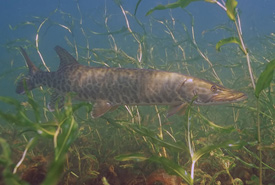
Muskellunge (Photo by U.S. Fish and Wildlife Service)
Northern pike is often mistaken for muskellunge, due to the species’ similar markings and size in adulthood. One can tell the difference between these species by looking at the underside of their lower jaw. Northern pike will have five or fewer pores on each side, while muskellunge will have six to nine. In addition, a northern pike’s cheek is completely covered in scales, while only the upper half of a muskellunge’s cheek will have scales.
Although not mentioned above, another pike species is tiger muskellunge. This species is a result of cross-breeding between the male northern pike with the female muskellunge. This breeding is often done in fisheries but can occur in the wild. These hybrids have five to eight pores on each side of their lower jaw.
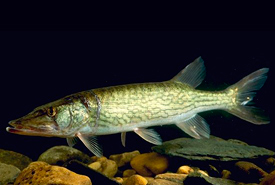
Chain pickerel (Photo by Ken Hammond)
Chain pickerel are an introduced species to Canadian waters. In Nova Scotia, the population of this species boomed due to the illegal introduction of small mouth bass in lakes and rivers. They reportedly coexist with native species of trout and salmon, despite having the same food source.
An overabundance of chain pickerel however could cause a depletion of native species, so its population is closely monitored. The species is also known to exist in Ontario. The first appearance of chain pickerel in Ontario was recorded in 2008.
So whether you catch a little grass pickerel or a beastly muskellunge, remember one thing: watch where you put your hands. These species have bite!
Something’s Fishy is a monthly series written by NCC’s Communications Assistant, Raechel Bonomo, highlighting a species or group of fishes that inhabitant Canadian waters.


